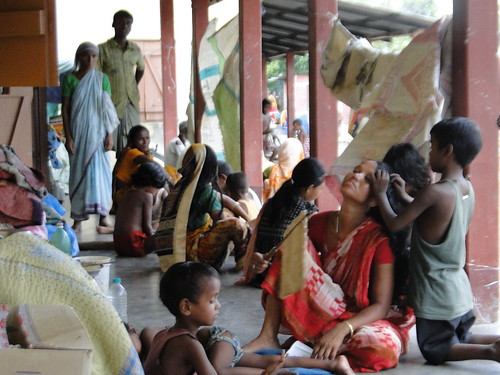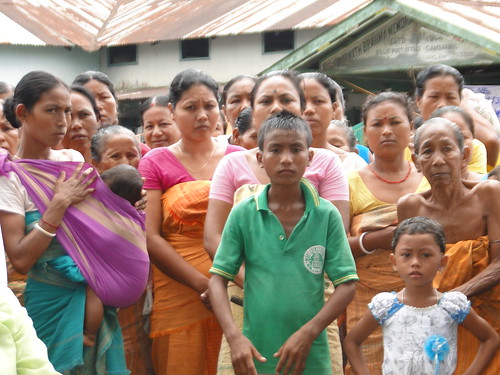By Mahtab Alam, for TwoCircles.net,
The author has just returned from Kokrajhar. He visited the violence affected areas as part of a civil society fact finding team from 7th to 11th August 2012.
Assam Violence 2012: Stories from the ground: Part 1
The Assam government’s claims of providing adequate and satisfactory relief to victims of the recent violence in parts of the state seem to have fallen flat as the ground reality seems to show otherwise – visible differences can be seen between the relief camps of the affected communities (Bodos and Muslims). After visiting more than a dozen relief camps—both Bodo and Muslim, one is left with the above impression, and this was simultaneously shared by a group of lawyers in Guwahati, who work with the Assam unit of Human Rights Law Network (HRLN). They were on a visit to the camps, to train and guide them on how to pursue the legal course of action in order to avail relief, rehabilitation, and most importantly, justice. The differences are in terms of facilities, capacity of occupancy, security and management.
While on one hand Bodo camps have adequate facilities, are less crowded, well managed and safely guarded; on the other hand, the Muslim camps are overcrowded, lacking in facilities, poorly managed (in fact, at times, not managed at all) and, highly vulnerable in terms of security. What follows are my observations of two relief camps in Kokrajhar district—one Bodo and the other Muslim.

Muslim inmates at the relief camp, Bhotgaon, Kokrajhar
At the Gambaribil School campus (visited on 8th August) in Gosaingaon subdivision of Kokrajhar district, there’s a relief camp for victims from Bodo community, which has an occupancy of 2,472 inmates comprising of 513 affected families. The camp was very neat and clean and properly managed. All the basic facilities and amenities were available to them, and the space provided was sufficient for the occupants. The occupants informed this writer about regular visits from the officials, timely disbursement of relief materials as well as provision of adequate medical facilities. A lot of visible importance was given to maintain health and hygiene in the camp (earlier, in a meeting with the DC Kokrajhar, Jayanta Narlikar, also informed us about law and order and health, hygiene being the two priorities that he was interested in maintaining). We even found a doctor advising the imamates, a rarity for the Muslim camps. There were volunteers and members of All Bodo Students Union (ABSU) in this camp, providing all possible help, from maintaining data, coordinating with government officials, monitoring the facilities and talking to (or translating for) the visitors.
However, the story of the camp at Bhotgaon School campus (visited on 10th August) in Kokrajhar Sadar subdivision is quite different, if not just the opposite. This place serves as a relief camp for victims of the Muslim community and has occupancy of 4,373 inmates (comprising 884 families) from 12 surrounding villages. The facilities available are dismal and it is highly over-crowded. As a result of this overcrowding, the male inmates have been sleeping out in the open. There are hardly any sufficient medical facilities, not to speak of the daily visit of a doctor, as narrated by the occupants of the Bodo camp. “The last visit by a doctor to our camp was 3 days ago”, said Amjad Ali, an inmate of the camp. We were told that on Friday, the relief material (provided by the government) had reached the camp after a gap of four days.
Similarly, with regard to the amount of security provided, the Bodo camp was guarded by jawans of the Central Reserve Police Forces (CRPF), while the Muslim camp was left in the hand of the State police, a force on whom neither of the two groups (Bodo and Muslim) has faith, for reasons known.

Bodo inmates at the relief camp, Gambaribil School, Gosaigaon, Kokrajhar
Notably, according to the list provided by the Deputy Commissioner office of Kokrajhar, Bhotgaon (Muslim) Relief camp had already been mentioned as closed. However in reality (till Friday evening), the camp was functional. As a result, even though the camp was occupied by a large number of inmates, the government stopped sending the rations. Thanks to the timely intervention by the team of lawyers, at least the ration has started arriving again.
It is obvious that the State government is primarily interested in making tall claims and is in a hurry to shut down the camps to reflect restoration of normalcy in the violence ridden region. Hence, it becomes imperative on the part of civil society and community organizations to closely monitor the process of relief and return, so that the minimum for a dignified existence can be attained without any discrimination.
Is anyone listening?
(Mahtab Alam is a Delhi based Civil Rights activist and journalist. He can be contacted at [email protected])

